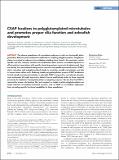| dc.contributor.author | Backer, Chelsea B. | |
| dc.contributor.author | Gutzman, Jennifer H. | |
| dc.contributor.author | Pearson, Chad G. | |
| dc.contributor.author | Cheeseman, Iain M | |
| dc.date.accessioned | 2012-07-23T15:08:54Z | |
| dc.date.available | 2012-07-23T15:08:54Z | |
| dc.date.issued | 2012-04 | |
| dc.date.submitted | 2012-03 | |
| dc.identifier.issn | 1059-1524 | |
| dc.identifier.issn | 1939-4586 | |
| dc.identifier.uri | http://hdl.handle.net/1721.1/71749 | |
| dc.description.abstract | The diverse populations of microtubule polymers in cells are functionally distinguished by different posttranslational modifications, including polyglutamylation. Polyglutamylation is enriched on subsets of microtubules including those found in the centrioles, mitotic spindle, and cilia. However, whether this modification alters intrinsic microtubule dynamics or affects extrinsic associations with specific interacting partners remains to be determined. Here we identify the microtubule-binding protein centriole and spindle–associated protein (CSAP), which colocalizes with polyglutamylated tubulin to centrioles, spindle microtubules, and cilia in human tissue culture cells. Reducing tubulin polyglutamylation prevents CSAP localization to both spindle and cilia microtubules. In zebrafish, CSAP is required for normal brain development and proper left–right asymmetry, defects that are qualitatively similar to those reported previously for depletion of polyglutamylation-conjugating enzymes. We also find that CSAP is required for proper cilia beating. Our work supports a model in which polyglutamylation can target selected microtubule-associated proteins, such as CSAP, to microtubule subpopulations, providing specific functional capabilities to these populations. | en_US |
| dc.description.sponsorship | National Institutes of Health (U.S.) (Grant no. GM074746) | en_US |
| dc.description.sponsorship | American Cancer Society. Research Scholar Grant (121776) | en_US |
| dc.description.sponsorship | National Institute of General Medical Sciences (U.S.) (GM088313) | en_US |
| dc.language.iso | en_US | |
| dc.publisher | American Society for Cell Biology | en_US |
| dc.relation.isversionof | http://dx.doi.org/10.1091/mbc.E11-11-0931 | en_US |
| dc.rights | Creative Commons Attribution–Noncommercial–Share Alike 3.0 Unported | en_US |
| dc.rights.uri | http://creativecommons.org/licenses/by-nc-sa/3.0 | en_US |
| dc.source | American Society of Cell Biology | en_US |
| dc.title | CSAP localizes to polyglutamylated microtubules and promotes proper cilia function and zebrafish development | en_US |
| dc.type | Article | en_US |
| dc.identifier.citation | Backer, C. B. et al. “CSAP Localizes to Polyglutamylated Microtubules and Promotes Proper Cilia Function and Zebrafish Development.” Molecular Biology of the Cell 23.11 (2012): 2122–2130. Copyright © 2012 by The American Society for Cell Biology | en_US |
| dc.contributor.department | Massachusetts Institute of Technology. Department of Biology | en_US |
| dc.contributor.approver | Cheeseman, Iain McPherson | |
| dc.contributor.mitauthor | Cheeseman, Iain McPherson | |
| dc.relation.journal | Molecular Biology of the Cell | en_US |
| dc.eprint.version | Final published version | en_US |
| dc.type.uri | http://purl.org/eprint/type/JournalArticle | en_US |
| eprint.status | http://purl.org/eprint/status/PeerReviewed | en_US |
| dspace.orderedauthors | Backer, C. B.; Gutzman, J. H.; Pearson, C. G.; Cheeseman, I. M. | en |
| dc.identifier.orcid | https://orcid.org/0000-0002-3829-5612 | |
| mit.license | PUBLISHER_POLICY | en_US |
| mit.metadata.status | Complete | |
